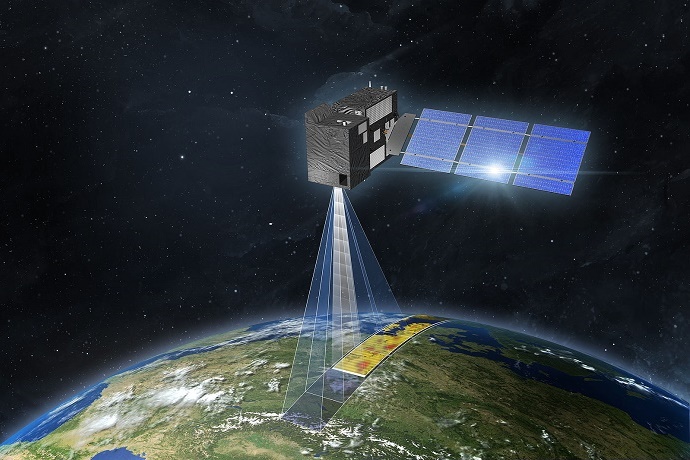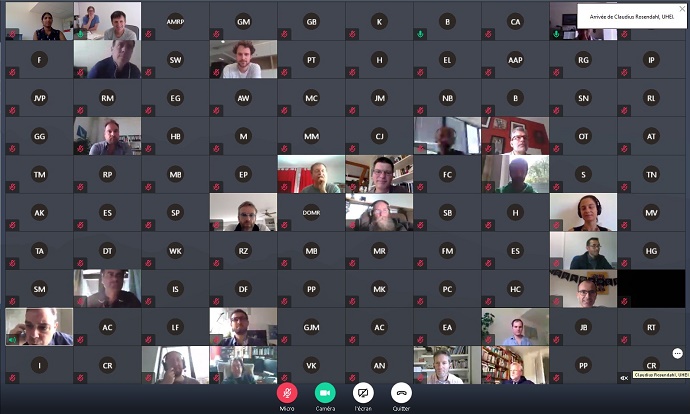

The CO2 monitoring capability will be supported by up to three satellites (Image copyright: OHB).
A European project to build a monitoring and verification support capability for global emissions of carbon dioxide (CO2) related to human activities is on track to deliver a prototype system by 2023, ECMWF’s project coordinator says.
The three-year EU-funded CO2 Human Emissions (CHE) project brings together 22 partner organisations from eight European countries and is coordinated by ECMWF. A follow-up project called Prototype system for a Copernicus CO2 service (CoCO2) is due to start in January 2021.
The future anthropogenic CO2 emission monitoring and verification support capability will support action on climate change in line with the Paris Agreement.
“We had a successful final CHE General Assembly in July together with the related VERIFY project, and I can confirm that we are on track to deliver a prototype system in 2023,” says ECMWF scientist Gianpaolo Balsamo, the coordinator of the CHE project.
Key CHE and CoCO2 requirements are to distinguish emissions related to human activities from other sources of CO2 in the atmosphere; monitoring CO2 emissions from local to global scales; and providing uncertainty estimates.
Achievements so far
The system that is being developed will estimate anthropogenic emissions of CO2 by means of dedicated high-resolution reanalysis. This method optimally combines a range of Earth observation data with model information in a process called data assimilation.
The results inevitably come with uncertainties. To investigate these, the prototype system will produce an ensemble of reanalyses based on slightly different assumptions.
“One of the biggest achievements of CHE to date is to have constructed a model ensemble for CO2 that is very good at characterising uncertainty, as widely used in weather forecasting,” says Gianpaolo.
“This enables us to work within a probabilistic framework for exceeding a given CO2 concentration on a given region and to attach levels of statistical significance to our estimates.”
This video explains how the new monitoring capability will help nations to assess whether the measures they take to reduce emissions are successful (credit: EMPA, ECMWF, CAMS, ESA).
Challenges ahead
Estimating carbon fluxes from atmospheric CO2 concentration measurements and other data is not easy. “One of the biggest challenges is to adapt the 4D-Var data assimilation system to enable the use of observations over an extended period of time, connecting CO2 atmospheric concentrations to their surface sources and sinks,” says Gianpaolo.
“The current 12-hour data assimilation window should ideally be extended to several days. This is something that hasn’t been done before at the level of granularity needed to support each country.”
Another challenge is that dedicated CO2 monitoring satellites will only be operational from 2026.
“Currently data from the Sentinel 5P satellite are used to measure nitrogen dioxide (NO2) as a proxy for human-related CO2 emissions, and some CO2 concentration measurements from other platforms are available too, but coverage and precision will be much better with the new Copernicus satellites,” Gianpaolo explains.
Towards a prototype
More than 100 participants came together in last month’s CHE-VERIFY virtual General Assembly. Several presentations were devoted to the impact of COVID-19 on greenhouse gas emissions and atmospheric concentrations.
They include a talk by ECMWF scientist Jérôme Barré on the activities of the EU-funded Copernicus Atmosphere Monitoring Service (CAMS) related to COVID-19.

The CHE-VERIFY General Assembly took place as a virtual event from 7 to 9 July 2020.
“The General Assembly took stock of progress in modelling, data assimilation and uncertainty characterisation,” Gianpaolo says.
A key concept to attain is the ‘inversion’ capability: it means estimating carbon fluxes that are optimally consistent with atmospheric CO2 concentration measurements.
“By the end of the year, we should have achieved a first 4D-Var-based CO2 inversion. It will be an excellent base on which we can build in the CoCO2 project with a view to having a prototype system in place by 2023.”
All General Assembly presentations can be found on the CHE project website.
